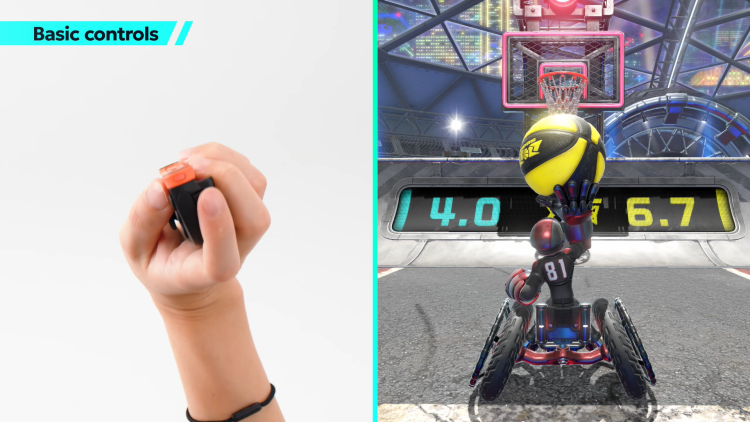Nintendo's Wheelchair Basketball Game Has 'Lack of Substance,' But Controls Like Nothing Else We've Played, Says IGN Review
Nintendo’s Drag x Drive is a game that pairs wildly unique motion-and-mouse-based controls with the fast pace of wheelchair basketball, and the result is a fresh gameplay experience that’s as demanding as it is rewarding. It feels like no other Nintendo sports title before it, with three-on-three matches that can be deep, competitive, and fun once you’ve learned its tricks. But outside those matches, it’s slim on features, customization, and personality, making it tough to keep coming back once the novelty fades.
In Logan Plant’s review for IGN, Drag x Drive is described as a game that takes risks with its control scheme, using the Joy-Con 2 in “mouse mode” to replicate the real-world motions of pushing a wheelchair, shooting a basketball, and communicating with teammates. Each Joy-Con controls one arm, and you physically slide the controller across a surface to move your wheels, flick your wrist to shoot, or wave to ask for a pass. It’s an ambitious system that’s more involved than Wii Sports, with advanced techniques to learn and a much higher skill ceiling, but it also means the game demands more patience – and physical effort – than most players might expect.
At first, the controls feel strange, even clunky, because the game asks you to do things no sports sim has before. Unlike motion games where your character moves automatically, here you control every push, brake, and turn. That leads to a steeper learning curve, especially when you’re losing points to opponents while still figuring out the basics. And there’s no button-based fallback – motion control is the only way to play. But once mastered, the controls open up an entire layer of gameplay depth.

The sole arena combines a traditional basketball court with skate park features, letting players pull off flashy stunts to earn fractional bonus points. A bunny hop during a shot adds 0.1 to the score, while a spinning 540-degree dunk adds 0.4, encouraging high-risk, high-reward plays. Defense can be just as intense, with mechanics for head-on collisions to strip the ball, physical blocks, and aggressive positioning to shut down drives.
The game’s responsiveness is impressive, but there’s a catch – it depends on the surface you’re playing on. Playing with Joy-Con 2s on your lap works inconsistently, with factors like pants fabric and wrinkles affecting tracking. Athletic shorts seem to work best, but many players will find a desk or table setup more reliable. Even then, slamming pricey controllers on hard surfaces can feel nerve-wracking.
Offline play with bots exists, but the heart of Drag x Drive is online competition. Three-on-three matches with real players are more dynamic, and the built-in GameChat makes coordination feel like an essential part of the game. Up to 12 players can gather in a shared “Park” hub, a gray, concrete space that hosts minigames and challenges between matches. Unfortunately, the Park lacks visual flair, energy, or meaningful activities to keep players engaged for long.

There are timed obstacle runs, jump rope challenges, and high-score shooting contests, but most can be cleared quickly. A scoreboard displays the current top scores in real-time, and record holders get gold rings for bragging rights, adding a nice competitive touch. Still, the extra content feels minimal – the minigames are skippable, and there’s no deeper progression system to drive long-term play.
Unlockables are limited to helmets for your character, with only slight variations in design, like adding bunny ears or spikes. There’s no character leveling, no alternate courts, and no original mascots or themed outfits to make the world stand out. Compared to other Nintendo multiplayer hits like Mario Kart or Splatoon, Drag x Drive feels barebones.
The lack of variety and personality is its biggest weakness. The gameplay core is solid, with real potential for a dedicated competitive scene, but there’s nothing substantial to work toward after the initial thrill of mastering the controls. This bare-minimum presentation stands in stark contrast to Nintendo’s usual attention to charm and detail.
There’s also the irony of its accessibility gap – a game inspired by wheelchair basketball forces players into physically demanding motion controls, with no adjustable settings to ease the experience. This limits its audience and makes it far from an inclusive design.
In the end, Drag x Drive is a strange mix of brilliant and barren. The on-court play is unlike anything else, rewarding skill, creativity, and quick reflexes with every match. Its stunt system makes scoring exciting, and its defensive mechanics capture the real-life energy of the sport. But with just one court, shallow customization, minimal off-court activities, and no compelling progression system, it struggles to hold attention in the long term. For players willing to commit to learning its unusual controls, there’s a lot to appreciate in the gameplay – but for everyone else, it’s easy to see this being a short-lived experiment in Nintendo’s sports lineup.
If Nintendo had paired Drag x Drive’s inventive gameplay with a richer world, more variety, and accessible control options, it might have been a breakout hit. As it stands, it’s a fascinating niche title – one that’s worth trying for its originality, but unlikely to earn a permanent spot in most players’ rotations.

Comments